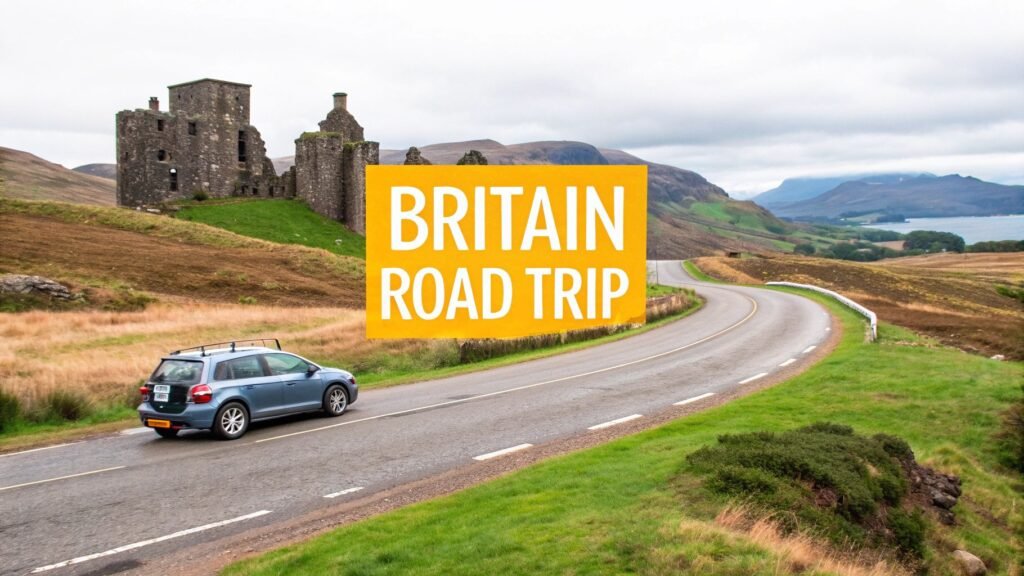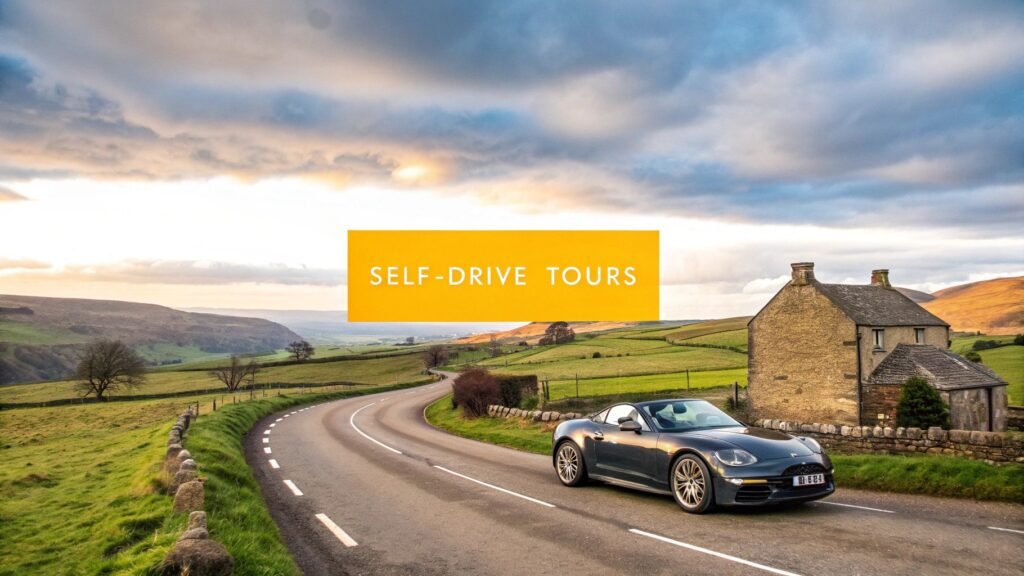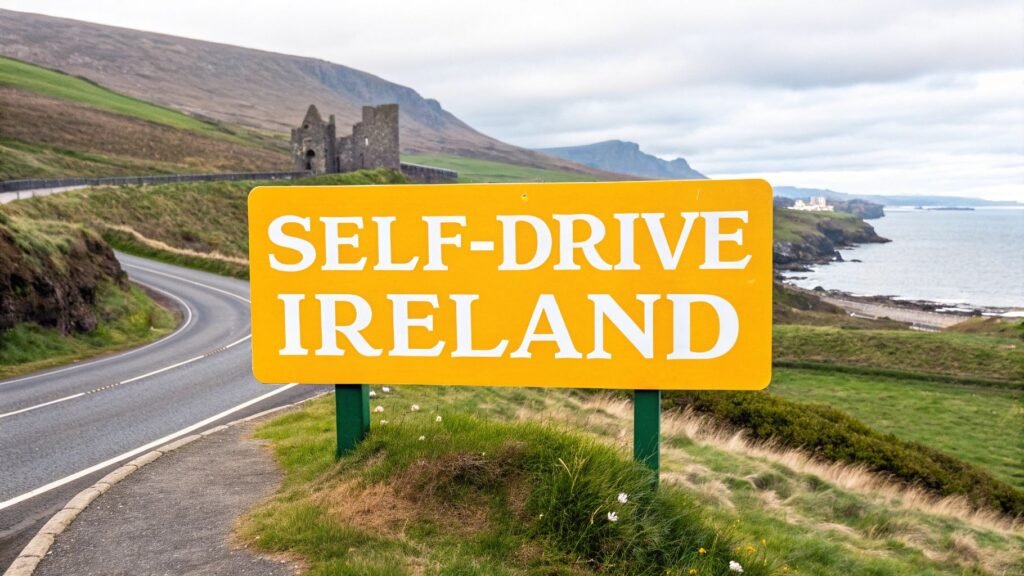There's nothing quite like the freedom of an England and Scotland self-drive tour. It’s your chance to explore the UK’s incredible landscapes on your own schedule, free from the rigid timetables of a group tour. Fancy spending an extra hour wandering through a sleepy Cotswold village? Or pulling over to photograph a castle ruin you've just spotted in the Scottish Highlands? This is what a road trip is all about.
This guide is your co-pilot, designed to help you plan that unforgettable British adventure.
Your Great British Road Trip Starts Here
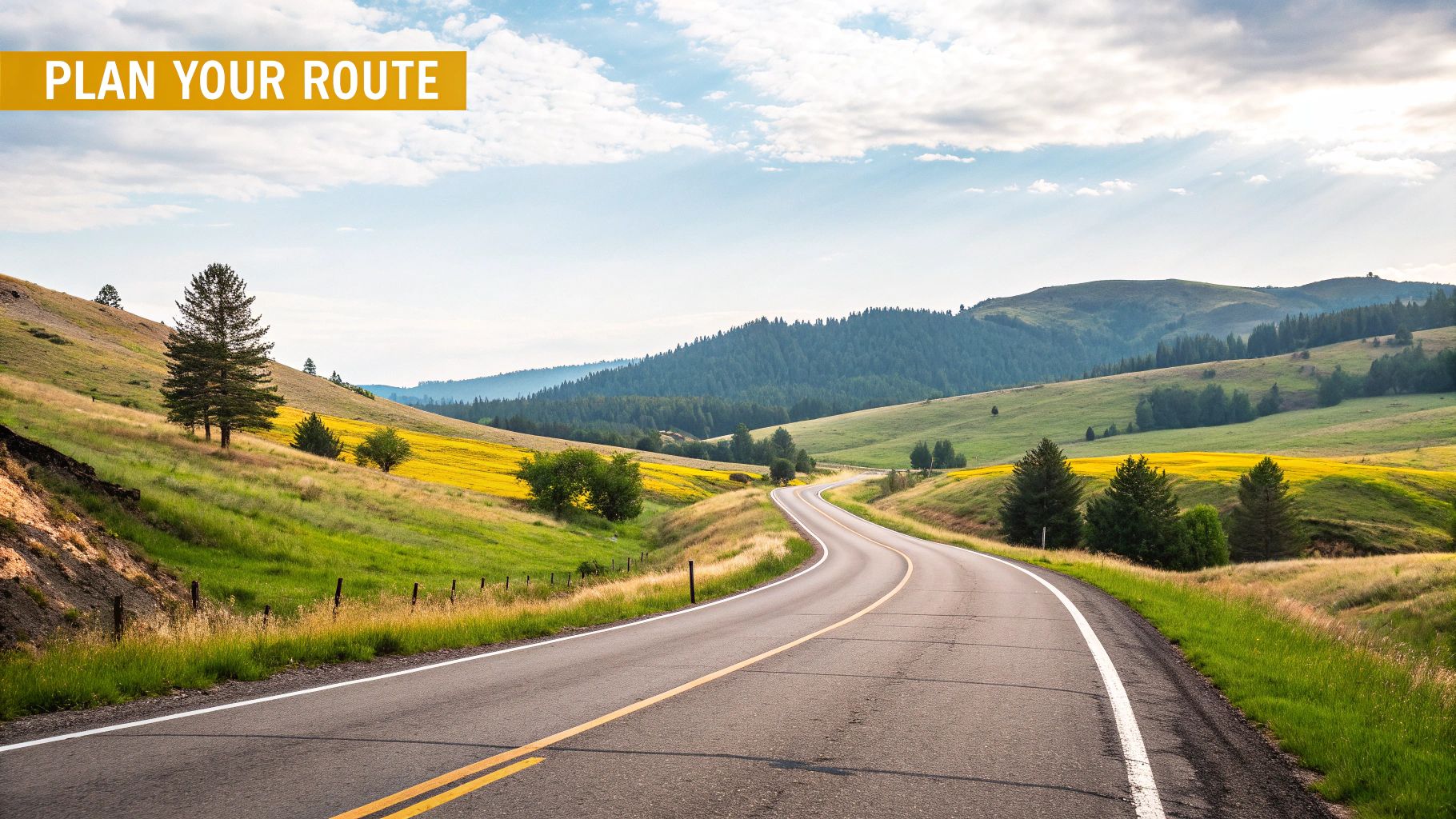
Picture yourself plotting a route through thousands of years of history, from the ancient Roman walls of York to the windswept battlefields of Stirling. A proper road trip isn't just about getting from point A to B. It’s about the spontaneous detours, the charming country pubs you stumble upon for lunch, and the breathtaking viewpoints that aren't in the guidebooks. It's the difference between watching Britain pass by a bus window and actually living it.
I've put this guide together to give you the confidence to get behind the wheel. We'll break down the whole planning process into simple, manageable steps, turning what can feel like an overwhelming task into a genuinely exciting part of the holiday itself. Whether you've done this a dozen times or it’s your first big driving trip, you'll find everything you need right here.
What to Expect from This Guide
We’re going to cover all the essentials for a smooth and memorable journey. Think of this as your personal travel planner, packed with practical advice and insider tips to help you craft an England and Scotland self-driving tour that’s perfect for you.
Here’s a little taster of what we’ll get into:
- Crafting Your Perfect Itinerary: I’ll lay out several distinct routes you can adapt, covering classic heritage trails and jaw-dropping scenic drives, all with realistic timings.
- Mastering UK Roads and Driving: We’ll get you comfortable with driving on the left, tackling roundabouts like a local, understanding road signs, and picking the right hire car for your trip.
- Finding the Best Places to Stay: Uncover the charm of countryside B&Bs, historic pubs with rooms, and cosy cottages, along with my top tips on when and where to book.
- Discovering Must-See Sights and Hidden Gems: I’ll point you towards the iconic landmarks you can't miss and share a few local secrets to make your trip truly special.
A self-drive tour is all about connecting with a place on your own terms. It’s the freedom to follow a winding lane just to see where it goes, or to linger for an extra hour watching the sunset over a Scottish loch.
Planning a trip of this scale really is part of the fun. By the time you're done with this guide, you won't just have a route map; you’ll have a personalised journey that truly reflects your own sense of adventure. Right then, let's start building your epic British road trip.
Crafting Your Perfect Itinerary
The real magic of an England and Scotland self-driving tour is the freedom it gives you. You're in complete control. Want to chase a sunset, pull over to explore a crumbling castle ruin, or just linger a little longer in a cosy village café? You can.
To help you get started, I’ve put together three different itineraries. Think of them as starting points, not rigid schedules, each designed for a different timeline and travel style.
Feel free to mix and match days, take that intriguing detour you just spotted on the map, or skip something that doesn't grab you. This is your adventure, so let these routes be your inspiration.
The Classic Heritage Trail
Duration: 2 Weeks (14 Days)
This route is a fantastic introduction to the heart of British history, weaving together iconic cities and timeless landscapes. It’s absolutely perfect if it's your first visit and you want to see the quintessential sights that have defined England and Scotland for centuries. You'll be walking through Roman history, wandering down medieval streets, and stepping inside royal palaces.
Here’s how a typical 14-day trip could look:
- London (Days 1-3): Your adventure begins in the bustling capital. Dive into history at the Tower of London, marvel at the Crown Jewels, and get lost in world-class museums like the British Museum.
- Bath & The Cotswolds (Days 4-5): Time to pick up your car. Head west to discover the ancient Roman Baths and elegant Georgian architecture of Bath. Then, it’s on to the storybook villages of the Cotswolds—places like Castle Combe and Bourton-on-the-Water are just waiting to be explored.
- York (Days 6-7): Drive north to the magnificent walled city of York. You can walk the ancient city walls, stand in awe of the York Minster, and meander down The Shambles, one of Europe's best-preserved medieval streets.
- Edinburgh (Days 8-10): Cross the border and get your first taste of Scotland! A hike up Arthur's Seat gives you incredible panoramic views of the city, while the formidable Edinburgh Castle and historic Royal Mile are must-sees.
- Return South via Lake District (Days 11-14): Head back towards England through the breathtaking scenery of the Lake District. A boat trip on Lake Windermere or a gentle hike is the perfect way to cap off the trip before your final drive.
The Scenic Wonders Route
Duration: 3 Weeks (21 Days)
If you're someone who craves wild landscapes, dramatic coastlines, and open roads, this is the itinerary for you. It deliberately puts nature front and centre, guiding you through some of the UK’s most spectacular national parks and legendary driving routes. It does require more time, but the payoff is unforgettable views.
This journey builds on the Classic Trail, adding more time for natural beauty:
- Lake District Immersion (Add 2 days): Give yourself more time to properly explore the fells and waters of this UNESCO World Heritage Site.
- Northumberland Coast (Add 2 days): Drive up England's stunning north-eastern coast, visiting dramatic castles like Bamburgh and the mystical Holy Island of Lindisfarne.
- The North Coast 500 (Add 3 days): From Edinburgh, make your way to Inverness to begin Scotland’s most famous road trip. This legendary 516-mile route loops around the rugged coast of the northern Highlands, offering some of the most spectacular scenery in Europe.
A self-drive tour is all about the journey, not just the destinations. The freedom to pull over at a stunning viewpoint in the Highlands or take a spontaneous turn down a winding country lane is what makes the experience truly your own.
A longer trip like this allows for a much more relaxed pace, giving you the time to really soak in the majesty of the British landscape.
This visual guide helps break down the driving distances between key stops, giving you a better sense of the trip's scale.
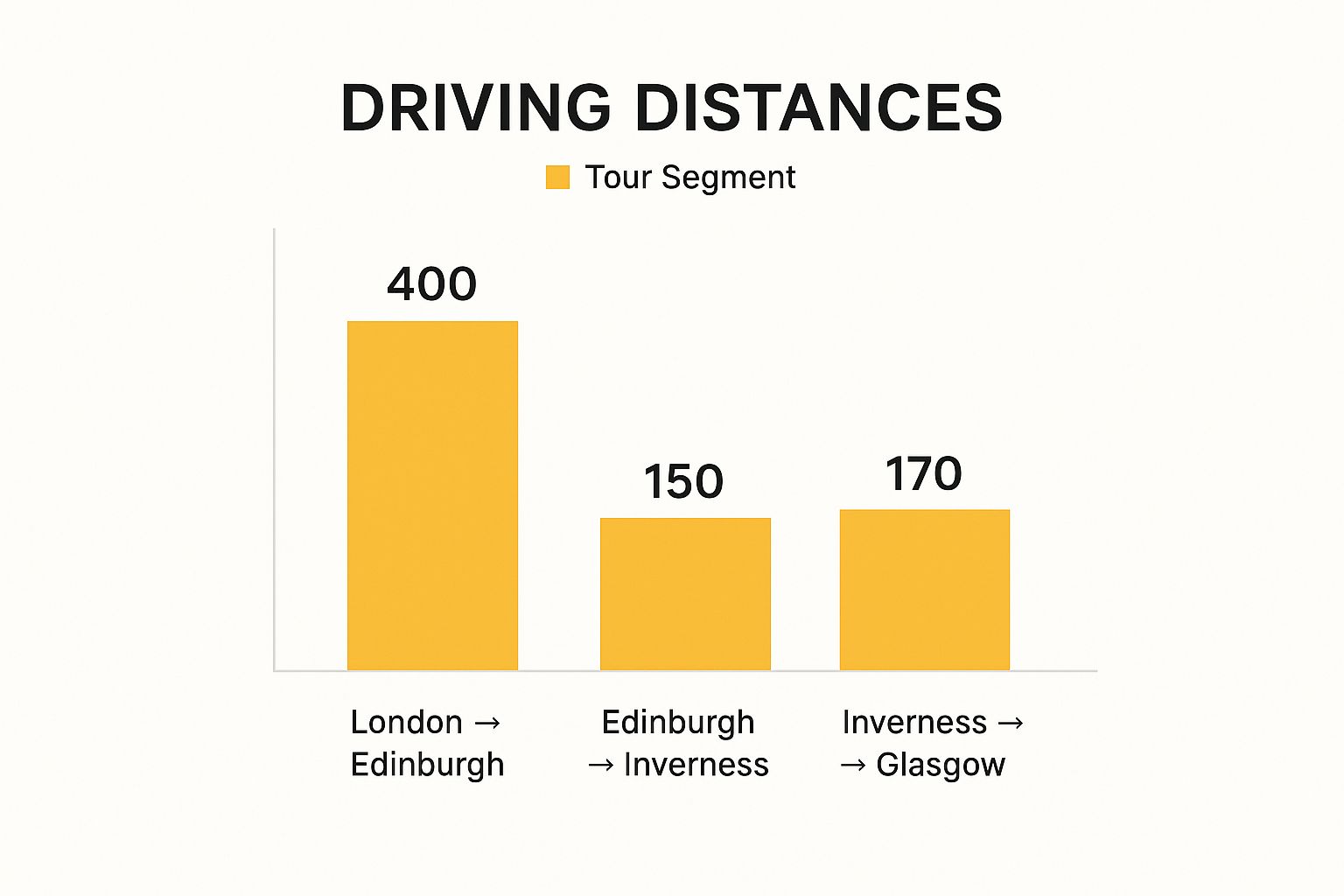
As you can see, the initial leg from London up to Edinburgh is the longest stretch. Once you're in Scotland, the drives become much shorter, leaving you with more time each day for leisurely exploration.
Sample 14-Day Itinerary Comparison
To help you decide which 14-day approach fits you best, here’s a quick comparison of the two main styles.
| Feature | Heritage Trail Itinerary | Scenic Wonders Itinerary |
|---|---|---|
| Main Focus | History, iconic cities, and major cultural landmarks. | Natural landscapes, national parks, and dramatic coastlines. |
| Major Stops | London, Bath, The Cotswolds, York, Edinburgh. | Lake District, Northumberland Coast, Scottish Highlands (Glencoe). |
| Ideal Traveller | First-time visitors, history buffs, those who love city exploration. | Nature lovers, hikers, photographers, and returning visitors. |
Both routes offer an incredible experience; it really just comes down to whether you're drawn more to the stories of the past or the beauty of the wild.
The Hidden Gems Exploration
Duration: 10 Days
Ready to get off the beaten path? This shorter, more focused itinerary steers clear of the main tourist hubs, uncovering the quieter, but no less captivating, corners of England and Scotland. It's a great option for repeat visitors or anyone looking for a more unique and local experience.
If you’re drawn to this kind of authentic journey but would prefer a slightly more structured plan, you might find some great ideas in this Taste of Scotland 8 Days Self Drive Tour.
A path less travelled could look something like this:
- Peak District (Days 1-3): Begin your trip in England's very first national park. Explore charming towns like Bakewell (home of the famous tart!), hike the dramatic ridges of Mam Tor, and visit the grand Chatsworth House.
- Yorkshire Dales (Days 4-5): Drive through classic James Herriot country, a landscape of stone-walled fields and rolling green hills. Discover beautiful waterfalls like Aysgarth Falls and the unique limestone pavement at Malham Cove.
- Cairngorms National Park (Days 6-8): Cross into Scotland and head for the UK's largest national park. Set up a base near Aviemore to explore ancient pine forests, spot wildlife like red deer, and drive the stunningly scenic Snow Roads.
- Return Journey (Days 9-10): Gently wind your way south, perhaps stopping in a charming border town like Jedburgh before your trip comes to an end. This route is all about quiet roads and authentic local encounters rather than just ticking off major landmarks.
Getting to Grips with Driving in the UK
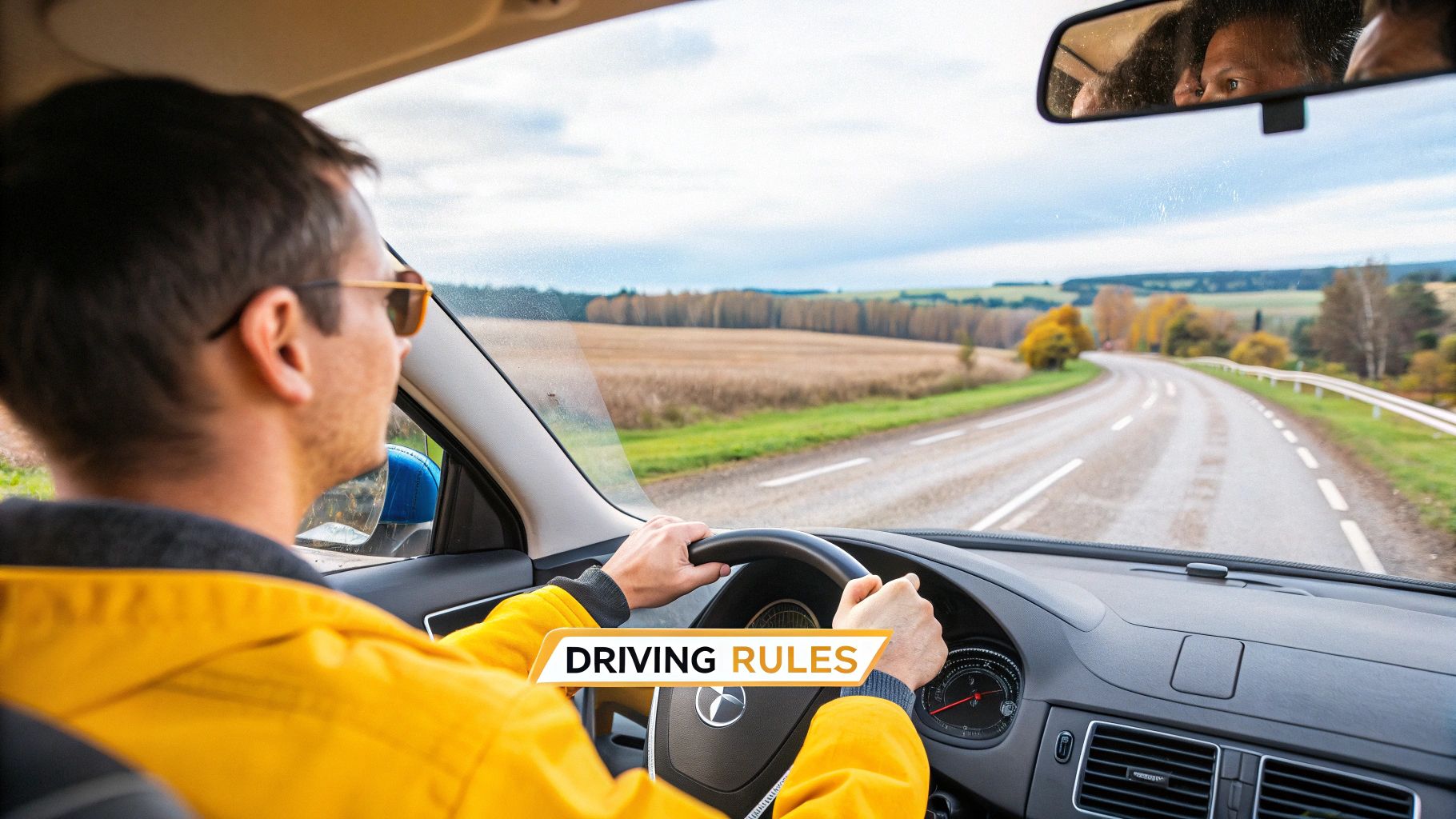
The idea of driving in a new country can feel a bit intimidating, but honestly, a little bit of prep work is all it takes to get you feeling confident for your England and Scotland road trip. It’s really just about mastering a few key differences, and that initial anxiety quickly turns into the pure joy of exploring the open road.
Let’s start with the big one: driving on the left. If you’re used to the right side of the road, this will feel a bit strange for the first hour or so, but you’d be amazed at how quickly your brain adjusts. I always tell people to remember one golden rule: the driver should always be in the centre of the road.
Keep that simple thought in mind, and it will naturally help you position the car correctly in your lane. When you first pick up your hire car, just spend a few minutes in the car park. Get a feel for the car's size and your new perspective from the driver's seat before you head out.
Navigating Roundabouts and Rural Roads
Roundabouts are everywhere in the UK, designed to keep traffic moving without endless traffic lights. The best way to think of them is as a one-way circular road. The absolute number one rule is to always give way to traffic already on the roundabout, which will be coming from your right. Once you see a safe gap, you can join and head to your exit.
When you're approaching a roundabout:
- Get in the right lane early. Signs on the approach will clearly show you which lane to use for your exit.
- Let others know what you're doing. Signal left as you pass the exit just before the one you want to take. It’s a huge help to other drivers.
- Don't panic! If you miss your exit, just go around again. It's so much safer than swerving at the last second.
You’ll also come across another quintessentially British feature, especially in the Cotswolds or up in the Scottish Highlands: the single-track road. These are narrow lanes, just wide enough for one car, but they have designated passing places dotted along them. The etiquette is simple – the car nearest a passing place on their side of the road should pull in and let the other vehicle pass. A friendly wave is always appreciated!
If I could give one piece of advice for UK roads, it would be this: stay calm, be courteous, and never feel rushed by the driver behind you. Taking your time is the secret to a safe and genuinely enjoyable drive, letting you actually focus on the incredible scenery around you.
Picking the Perfect Hire Car
Choosing the right car is a bigger deal than you might think, and the best choice really comes down to your itinerary. For zipping through narrow city streets or winding country lanes, a smaller, compact car is an absolute dream. It makes parking a doddle and will save you a fair bit on fuel, too.
On the other hand, if you're planning some serious mileage through the rugged Scottish Highlands or tackling the North Coast 500, you'll probably be grateful for the extra comfort and power of a slightly larger car or an SUV. Think about how much luggage you'll be carrying and how many of you there are. For a look at some great options matched to specific routes, have a browse through our recommended self-drive tours.
A quick note on fuel: it's sold by the litre here, not the gallon, and prices might be higher than you're used to. Most hire cars take either unleaded petrol (green pump) or diesel (black pump). Always, always double-check which fuel your car needs before you fill up!
Key Rules of the Road
Staying safe is all about knowing the local laws. With human error contributing to around 88% of road accidents in the UK, paying close attention to the rules is the best way to ensure a stress-free trip.
Here are the essentials you need to remember:
- Speed Limits: All speed limits are posted in Miles Per Hour (MPH). Look for a circular sign with a red border and a number inside – that's your maximum speed. A white circle with a black diagonal line means the national speed limit applies.
- National Speed Limits: For a car on a single carriageway (a road with no central reservation), this is 60 MPH. On a dual carriageway or motorway, it’s 70 MPH.
- London's Congestion Charge: If your journey takes you right into central London, be aware of the Congestion Charge zone. You have to pay a daily fee to drive within this area during certain hours, and forgetting to do so will land you a hefty fine.
Finding the Best Places to Stay
Your choice of accommodation is so much more than just a place to sleep; it’s a huge part of what makes a road trip through England and Scotland truly special. Trading a generic hotel for a room above a centuries-old pub or a cosy cottage tucked away in the countryside is how you create the memories that really last. The right stay connects you to a place, turning a simple overnight stop into an unforgettable part of the journey.
Thankfully, the UK is packed with an incredible variety of places to rest your head. You can find everything from charming bed and breakfasts where the owner cooks you a proper full English, to grand castle hotels that feel like stepping back in time. This sheer variety is what allows you to craft an adventure that’s truly your own.
Choosing Your Accommodation Style
The kind of place you stay in can completely shape your daily experience. A city-centre hotel offers brilliant convenience for sightseeing, but a rural farmhouse provides a welcome, peaceful escape after a long day behind the wheel. Getting to know the pros and cons of each will help you mix and match to create your perfect itinerary.
Here’s a quick rundown of the most popular options:
- Bed & Breakfasts (B&Bs): Often family-run homes offering a wonderfully warm and local experience. They’re perfect if you’re looking for personal touches and insider tips on the best things to see and do.
- Pubs with Rooms: A quintessentially British experience! Stay above a traditional pub for fantastic food, local ales, and a lively, friendly atmosphere literally on your doorstep.
- Self-Catering Cottages: Ideal for families, groups, or longer stays in one spot. They give you the freedom to cook your own meals and get a real taste of what it's like to live there.
- Hotels: Ranging from budget-friendly chains to luxurious boutique properties, hotels offer reliability and handy amenities like on-site restaurants and a front desk.
Booking your accommodation isn't just a logistical chore; it's a chance to go deeper. Choosing a historic inn in the Cotswolds or a loch-side B&B in Scotland makes the journey itself just as memorable as the destinations.
When to Book and When to Be Spontaneous
Planning your stays is always a bit of a balancing act between having a secure plan and leaving room for spontaneity. For certain hotspots, booking months ahead isn't just a good idea—it's absolutely essential. Hugely popular destinations like the Isle of Skye, the Lake District, and coastal Cornwall have limited accommodation that gets snapped up incredibly fast, especially from June to August.
On the other hand, if you're exploring less-travelled routes or travelling in the shoulder seasons (think May and September), you can afford to be much more flexible. This freedom lets you linger in a village you’ve fallen in love with or follow an unplanned detour to somewhere that looks interesting. A great strategy is to book your weekend stays and any absolute must-see locations well in advance, but leave a few midweek nights open for those spontaneous discoveries.
A Guide to Your Accommodation Budget
Accommodation will likely be one of your biggest expenses, but with a bit of smart planning, you can definitely keep costs under control. Prices swing wildly depending on the location, time of year, and type of property you’re looking at.
Here are some typical nightly price ranges to help you get started with your budget:
| Accommodation Type | Average Price (Per Night) | Best For |
|---|---|---|
| B&B / Guesthouse | £70 – £120 | Authentic local experiences and hearty breakfasts. |
| Pub with Rooms | £80 – £150 | Convenience, character, and great evening meals. |
| Mid-Range Hotel | £100 – £200 | City stays and reliable comfort. |
| Self-Catering Cottage | £90 – £180+ | Families, groups, and week-long stays. |
It's often worth checking if you can book directly with the property, as you can sometimes find better rates or little perks. For browsing a massive range of options, platforms like Booking.com are excellent. For finding unique cottages, especially if you’re travelling with a group, sites like VRBO can be a goldmine. Don't be afraid to mix and match to get the best of all worlds
Finding Your Perfect Mix of Famous Sights and Hidden Gems

An England and Scotland self-drive tour is your ticket to seeing it all—from the legendary landmarks you've read about for years to the quiet, secret spots that truly capture the spirit of Britain. This is your chance to build a trip that perfectly balances the bucket-list icons with your own unique discoveries.
Think of it this way: the famous sights are the backbone of your trip, giving it structure and hitting those must-see notes. But it’s the hidden gems you stumble upon that will add the real colour and create the stories you'll tell for years to come.
Let's look at how you can weave both into your road trip, ensuring you get a real feel for these incredible countries, from ancient standing stones to wild, windswept coastlines.
Essential Landmarks in England
No first-time visit to England is really complete without ticking off some of its world-famous historical sites. These are the places that have shaped the nation's story, and there's a powerful feeling that comes from standing right where history was made. Seeing them in a book is one thing; walking their grounds is something else entirely.
These spots are, of course, very popular. To sidestep the worst of the crowds, try to visit first thing in the morning or later in the afternoon. And a golden rule: always book your tickets online and in advance. You'll secure your entry and often save a few quid, too.
Here are a few absolute musts for your list:
- Stonehenge: This prehistoric stone circle in Wiltshire is wrapped in mystery and is, without doubt, one of the most famous sights in the world. The sheer age and scale of it will leave you speechless.
- The Tower of London: A fortress, a royal palace, and an infamous prison. Its nearly 1,000-year history feels alive as you walk the ancient battlements and get a glimpse of the dazzling Crown Jewels.
- Bath’s Roman Baths: Journey back two millennia to explore one of the best-preserved Roman spas from the ancient world. The city of Bath itself is a gorgeous UNESCO World Heritage site worth a full day of wandering.
These landmarks provide a fantastic foundation for your journey. If you want some inspiration for a route that ties England's heritage together beautifully, check out something like the Taste of England 8 Days Self Drive Tour.
Uncovering England's Hidden Charms
Beyond the big names, a quieter, more intimate England is waiting. These are the places that reward the curious traveller, offering authentic moments far from the well-trodden tourist path. A self-drive tour gives you the total freedom to go and find them.
Instead of just hopping between major cities, build in some time to meander through the regions in between. This is where you’ll find the true character of the country.
- The Fishing Villages of Cornwall: Move past the crowds at St Ives and discover smaller gems like Mousehole or Cadgwith, where colourful fishing boats bob in tiny, picturesque harbours.
- Hadrian's Wall Country: Take a drive along the remnants of the Roman Empire's northern frontier. The landscape here is wild, rugged, and hauntingly beautiful, with forts like Housesteads offering unbelievable views.
- Northumbria's Coastline: This often-overlooked stretch of coast has some of Britain’s most dramatic castles, including the mighty Bamburgh Castle, and the serene, tidal Holy Island of Lindisfarne.
A great road trip isn't just about the destinations you've marked on a map. It's about the unexpected discoveries—the charming village pub you stop at for lunch, the stunning viewpoint you find down a random country lane, or the friendly local who points you to a hidden beach.
Scotland's Unforgettable Icons
Once you cross the border into Scotland, the scenery and the history take on a dramatic new character. Here, the icons are a powerful blend of majestic nature and formidable human history. These are the sights that define Scotland for the world.
Just like in England, these attractions are incredibly popular, especially in the summer. Pre-booking isn't just a good idea; for places like Edinburgh Castle, it’s absolutely essential if you want to avoid being turned away.
- Edinburgh Castle: Perched on a volcanic rock and dominating the capital's skyline, this historic fortress is the very heart of Scotland’s story.
- Loch Ness: While hunting for the monster is the main draw, the vast, deep loch is captivating in its own right. The best way to appreciate its immense scale is from a boat on the water.
- Glen Coe: Driving through this spectacular glen is a Scottish rite of passage. The towering, moody mountains seem to tell stories of clan history and raw, natural power.
Delving into Scotland's Secret Sanctuaries
The real magic of Scotland is often found just a short detour from the main road. Your car is the key to unlocking some of the most enchanting and remote parts of the country, where you can feel a million miles from the daily grind.
- The Fairy Pools on Skye: A truly magical walk to a series of crystal-clear blue pools and waterfalls that tumble down from the Black Cuillin mountains. Get there early to experience it before the crowds arrive.
- The Trossachs National Park: Often called 'The Highlands in Miniature,' this area is an easy drive from Glasgow and Edinburgh but offers serene lochs, quiet forests, and fantastic walking trails without the long journey north.
- The Standing Stones of Orkney: If you have time for a ferry trip, the Neolithic sites on the Orkney Islands are a must. Places like the Ring of Brodgar are older than Stonehenge and feel incredibly atmospheric.
Planning your time at each of these spots—both big and small—is key to a smooth trip. You don't want to feel rushed, but you also want to make the most of your day.
UK Attraction Planning Guide
To help you get a sense of how much time to set aside, here’s a quick guide to some of the top attractions across the UK.
| Attraction | Location | Recommended Visit Time | Pro Tip |
|---|---|---|---|
| Tower of London | London, England | 3-4 hours | Arrive at opening time to see the Crown Jewels before the queues build. |
| Stonehenge | Wiltshire, England | 2 hours | The audio guide is excellent and really brings the history of the stones to life. |
| Roman Baths | Bath, England | 2-3 hours | Give yourself extra time to explore the beautiful Georgian city of Bath afterwards. |
| Edinburgh Castle | Edinburgh, Scotland | 3-4 hours | Book tickets online for a specific time slot well in advance, especially in summer. |
| Glen Coe | Highlands, Scotland | 1-3 hours (driving) | Allow plenty of time for photo stops. The viewpoints are clearly marked. |
| Loch Ness Cruise | Highlands, Scotland | 1-2 hours | A boat tour is the best way to appreciate the loch's immense size and beauty. |
This table should give you a solid starting point for mapping out your daily itineraries and ensuring you have enough time to truly enjoy each incredible location.
Answering Your UK Road Trip Questions
The thought of an open-road adventure through England and Scotland is thrilling, but it’s completely normal to have a few practical questions buzzing around before you lock anything in. Getting these sorted will help you feel much more confident about hitting that 'book' button.
Let's dive into the most common queries we hear, from when to visit to the nitty-gritty of driving on this side of the pond.
What’s the Best Time of Year for This Road Trip?
Picking the right season can make a huge difference to your trip. It affects the weather, how much daylight you get for exploring, and how busy the attractions are. While you can visit the UK any time, some months are definitely better than others for a driving holiday.
I've always found the sweet spot to be late spring (May-June) or early autumn (September-October). You get the benefit of pleasant, milder weather and longer days without the crowds and peak prices of summer. Spring is just spectacular, with the countryside bursting into colour, while autumn serves up a stunning display of golden landscapes, especially in the Scottish Highlands.
Summer (July-August) is lovely and warm, of course, but it’s also when schools are out, so expect more traffic and higher prices. Winter brings its own magic, but shorter days and the real possibility of snow closing roads up north make it a trickier choice for a first-timer.
Do I Need a Special Permit to Drive in the UK?
This is a big one for visitors from overseas, but thankfully, the answer is usually quite simple. If your driving licence is in English (like those from the US, Canada, or Australia), you’re generally good to go for up to 12 months without needing an International Driving Permit (IDP).
If your licence isn’t in English, however, you will need to have an IDP or a certified, official translation with you at all times, along with your original licence. It’s always a good idea to have a quick look at the official UK government website before you fly, just in case rules have changed.
How Much Should I Budget for Fuel?
Don’t underestimate this one! Fuel (or petrol, as we call it) is a major part of any UK road trip budget. We sell it by the litre, not the gallon, and you'll probably find it's more expensive than what you're used to back home. A good rule of thumb is to budget for around £1.50 to £1.70 per litre for either petrol or diesel.
So, what does that actually mean for your wallet? For a 1,500-mile trip in a car that does about 40 miles per gallon (which is roughly 8.8 miles per litre), you can expect to spend somewhere in the region of £250-£300 on fuel. An online route planner with a fuel calculator can give you a more accurate figure for your specific route.
And for those thinking of bringing a four-legged friend on their travels, you’ll find some great advice on how to travel with dogs in the UK.
Can I Just Park and Sleep in My Car or Van Anywhere?
This is where it's crucial to know the local rules, as they are completely different in England and Scotland.
Scotland is more relaxed thanks to its 'right-to-roam' laws, which allow for informal or "wild" camping in many places. However, this comes with a huge responsibility to follow the Scottish Outdoor Access Code – basically, leave no trace. It's also worth knowing that some popular areas, like Loch Lomond, have local byelaws that ban overnight parking to protect the environment.
England and Wales are much stricter. Wild camping without the landowner's direct permission is illegal. You must use official campsites or designated motorhome spots. Honestly, for peace of mind and to ensure you’re being respectful, using official sites is the best and safest bet in both countries.
At BTOURS, we take all the guesswork out of planning. Our expertly designed self-drive tours give you detailed itineraries, pre-booked accommodations, and all the support you need for a stress-free adventure. Explore our curated journeys and find your perfect British road trip today. https://www.btours.com

